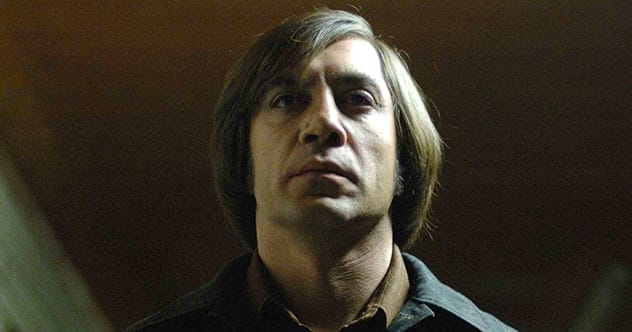Psychopaths are rare, making up only about 1% of the population. Their capacity for cruelty is unsettling. Dr. Kevin Dutton describes their traits as ruthlessness, fearlessness, impulsivity, high self-confidence, coolness under pressure, charm, reduced empathy, and a lack of conscience. They can inflict harm without remorse.
However, cinematic portrayals of psychopaths aren’t always accurate. Psychiatry professor Samuel Leistedt and his team watched over 400 movies from 1915 to 2010 to identify truly psychopathic characters.[1] They found 126 believable psychopaths, with only 21 being female. Leistedt noted that characters like Patrick Bateman from “American Psycho,” Norman Bates from “Psycho,” and Hannibal Lecter from “Silence of the Lambs” are more like “universal boogeymen” than true psychopaths. So, who really makes the cut? Let’s explore.
Alonzo Harris
In “Training Day” (2001), Alonzo Harris (Denzel Washington) embodies the bad cop archetype, operating amidst gang culture and police corruption in South Central Los Angeles. Over 24 hours, he tests rookie cop Jake Hoyt (Ethan Hawke) to gauge his character.
Alonzo disregards professional and personal boundaries, a hallmark of psychopathic behavior. They exploit others’ weaknesses for personal gain. While normal people enjoy social interactions, psychopaths use them to gain an advantage. Professor Kibeom Lee explains that traits like deceitfulness and conceitedness predict the tendency to exploit others.[2]
Denzel Washington often cites Alonzo Harris as his favorite role.
Catherine Tramell
Catherine Tramell (Sharon Stone) in “Basic Instinct” (1992) is a highly intelligent, manipulative, and charismatic novelist who inherited $110 million after her parents’ death.
In “Basic Instinct 2” (2006), Dr. Michael Glass analyzes Catherine as addicted to risk, driven by a compulsive need to prove she can survive dangers others can’t. The greater the risk, the greater her sense of omnipotence.[3]
High-functioning psychopaths often have a genetic predisposition to fearlessness, leading them to take extreme risks. This can ensnare innocent people in their games, with unfortunate consequences. Catherine herself admits, “I have a degree in psychology… Games are fun.”
Gordon Gekko
Gordon Gekko (Michael Douglas) in “Wall Street” (1987) is the quintessential corporate psychopath. As the founder of Gekko & Co., with a net worth of $650 million, he famously declares, “Greed is good.”
Statistically, the highest concentration of psychopaths is at the top of the corporate ladder, with 4% to 12% of CEOs exhibiting psychopathic traits. Psychologist Kevin Dutton notes that top career choices for psychopaths include CEO, attorney, media personality, and salesperson.
In “Snakes in Suits,” Paul Babiak and Robert Hare reveal that workplace conflicts often stem from psychopathic leaders who manipulate people against each other.[4] These workplace psychopaths are puppetmasters, and Gordon Gekko is a prime example.
George Harvey
In “Lovely Bones” (2009), George Harvey (Stanley Tucci) murders 14-year-old Susie Salmon (Saoirse Ronan). Susie’s spirit watches her family, trying to reveal George as her killer.
George is a creepy loner obsessed with dollhouses. His underground lair near the school is where he lures young girls to their deaths. He embodies the psychopathic serial killer who is “hiding in plain sight.”
Former FBI agent John Douglas explains that people often expect violent offenders to be obviously monstrous. However, many serial killers blend in, with 20 to 50 active in the U.S. at any time.[5] Tucci prepared for the role by role-playing with Douglas, aiming to portray psychopaths as more human than monstrous. His performance earned him an Academy Award nomination.
Sergeant William James
“The Hurt Locker” (2008) introduces Sergeant William James (Jeremy Renner), an Explosives Ordnance Disposal technician. His reckless methods and laidback attitude create tension within his team.
Despite high-stress situations, Sgt. James compartmentalizes the stress and moves on, unlike his teammate, Specialist Owen Eldridge (Brian Geraghty), who seeks psychological help. This ability to focus under pressure is a sign of psychopathy.
Dr. George Simon argues that the ability to compartmentalize emotion is more insidious than a lack of conscience. Psychopaths can appear caring but can easily switch off any empathy.[6]
Hedra Carlson
Hedra Carlson (Jennifer Jason Leigh) is the antagonist in “Single White Female” (1992). Like Catherine Tramell, Hedra uses male lust to her advantage. Leistedt’s team found that female psychopaths are often portrayed as manipulative schemers who weaponize sexuality.
Hedra is also a pathological liar. Psychopaths are adept at lying, making others doubt themselves even with contrary evidence. This behavior helps them maintain power in relationships.
Preston Ni explains that psychopaths will make up and say anything to gain power, using lies, distortions, deceptions, broken promises, and victim-blaming to advance their schemes.[7]
Annie Wilkes
In “Misery” (1990), Annie Wilkes (Kathy Bates) traps writer Paul Sheldon (James Caan) because she is his “number one fan.” Annie displays violent mood swings and is a complete narcissist.
Annie reveals her narcissism by forcing Paul to burn his manuscript due to its foul language. She also insists he rewrite the novel to revive her favorite character.
While not all psychopaths are narcissists, Annie’s scheming and manipulative ways highlight her psychopathic side. She stops at nothing to get what she wants. A test for psychopathy? Watch the hobbling scene and see if your partner looks away.[8]
Hans Beckert
In “M” (1931), Hans Beckert (Peter Lorre) lures a little girl to her death, causing panic in Berlin. He is a sadistic pedophile and serial killer. This German thriller is considered a cinematic masterpiece.
Beckert’s charisma allows him to kill undetected for a long time. Like George Harvey, he blends into society while committing heinous acts.
Researchers describe Beckert as an outwardly unremarkable man tormented by compulsions.[9] Psychopaths can’t ignore impulsive desires, seeking sensation and excitement, even through extreme violence. Beckert pleads, “Who knows what it is like to be me?” when his evil is revealed.
Henry
“Henry: Portrait of a Serial Killer” (1986) is based on Henry Lee Lucas. Michael Rooker plays Henry, released from prison for murdering his mother, only to resume his violent ways. With Otis Toole (Tom Towles), they embark on a meticulously planned killing spree.
Lucas was convicted of 11 murders but claimed responsibility for over 3,000. He randomly targeted victims in the early 1980s while drifting across states with Toole.
Lucas blamed his mother for his psychopathy, citing humiliation and abuse. In 1960, he killed her after years of abuse and was later paroled after ten years in a state hospital.[10] Rooker’s portrayal of Henry is a career highlight.
Anton Chigurh
After analyzing over 400 movies, experts deemed Javier Bardem’s Anton Chigurh in “No Country For Old Men” (2007) the most believable on-screen psychopath. They described him as invulnerable and devoid of emotion or humanity.
This adaptation of Cormac McCarthy’s novel follows the entangled lives of Llewelyn Moss (Josh Brolin), who finds $2 million from a drug deal gone wrong, and Anton Chigurh. Directed by Joel and Ethan Coen, it won four Academy Awards, including Best Picture.
Bardem explained that Anton is a man of his word, a symbol of violent fate. When violence appears, it creates misery and pain, leading nowhere.[11]
These characters offer a chilling look into the minds of movie psychopaths, offering a glimpse into their cold, calculating, and often terrifying actions.
Which of these movie psychopaths chilled you the most? Leave your comment below!










